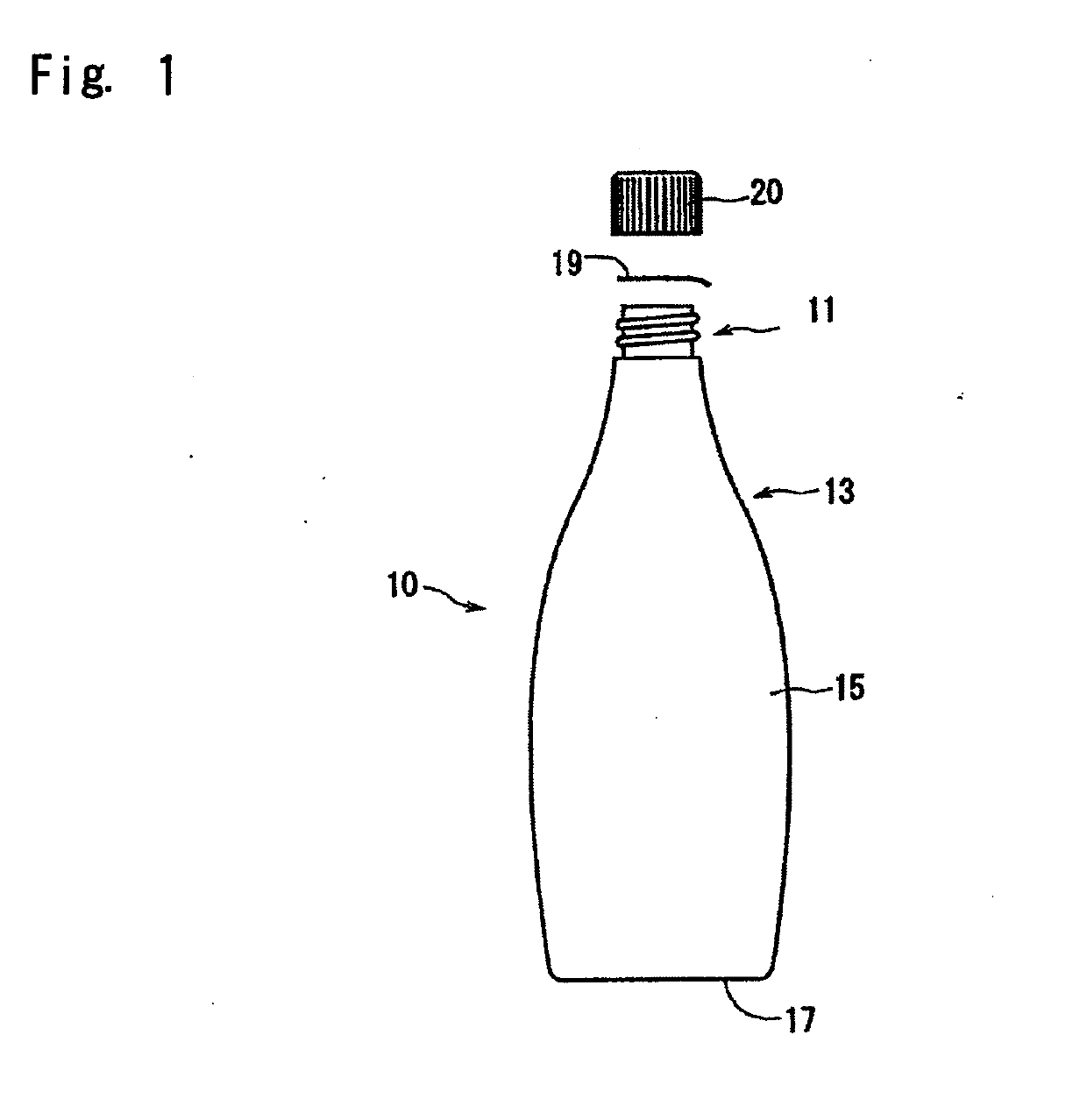Adhesive for polyolefin and multilayered structure
a polyolefin and multi-layer technology, applied in the field of adhesives for polyolefins, can solve the problems of low squeezing ability, lack of rigidity, and lack of dent in the body portion of the container, and achieve the effect of preventing peeling, less branches, and excellent adhesiveness
- Summary
- Abstract
- Description
- Claims
- Application Information
AI Technical Summary
Benefits of technology
Problems solved by technology
Method used
Image
Examples
example 1
[0068]There were provided the following resins and liquids for forming the layers and for forming the liquid film on the inner surface.
Resins for Forming the Inner Layer;
[0069]High pressure low-density polyethylene (LDPE)[0070]MFR: 0.3 g / 10 min (190° C., 2.16 kg)[0071]Density: 0.922 g / cm3 [0072]Cyclic olefin resin (COC);[0073]Ethylene-tetracyclododecene copolymer[0074]MFR: 30 g / 10 min (260° C., 2.16 kg)[0075]Density: 1.02 g / cm3 [0076]Tg: 80° C.[0077]Gas phase linear low-density polyethylene (LLDPE)[0078]MFR: 7.0 g / 10 min (190° C., 2.16 kg)[0079]Density: 0.922 g / cm3
Resin for Forming the Outer Layer and Main Layer;
[0080]Ethylene-propylene random copolymer resin (PP)[0081]MFR: 1.3 to 1.9 g / 10 min[0082]Density: 0.90 g / cm3
Resin for Forming the Adhesive Layer;
[0083]Maleic anhydride-modified polyethylene A (resin A)[0084]Described below is the structure of the branched chains of the resin A measured by the above-mentioned method.[0085]Methyl group: 20.3[0086]Ethyl group: 0[0087]Butyl gro...
example 2
[0100]A multilayered bottle was formed in the same manner as in Example 1 but using the high pressure low-density polyethylene (LDPE) only as the resin for forming the inner layer.
[0101]The thus produced bottle was measured for its constitution and evaluated for its adhesiveness as described above. The results were as shown in Tables 1 and 2.
example 3
[0102]A maleic anhydride-modified polyethylene B (resin B) was provided as the resin for forming the adhesive layer.
[0103]Described below was the structure of the branched chains of the resin B measured by the above-mentioned method.
[0104]Methyl group: 11.1
[0105]Ethyl group: 0
[0106]Butyl group: 4.1
[0107]Pentyl group: 2
[0108]A multilayered bottle was formed in the same manner as in Example 1 but using the above-mentioned as the resin for forming the adhesive layer.
[0109]The thus produced bottle was measured for its constitution and evaluated for its adhesiveness as described above. The results were as shown in Tables 1 and 2.
PUM
| Property | Measurement | Unit |
|---|---|---|
| adhesive | aaaaa | aaaaa |
| flexibility | aaaaa | aaaaa |
| viscous | aaaaa | aaaaa |
Abstract
Description
Claims
Application Information
 Login to View More
Login to View More - R&D
- Intellectual Property
- Life Sciences
- Materials
- Tech Scout
- Unparalleled Data Quality
- Higher Quality Content
- 60% Fewer Hallucinations
Browse by: Latest US Patents, China's latest patents, Technical Efficacy Thesaurus, Application Domain, Technology Topic, Popular Technical Reports.
© 2025 PatSnap. All rights reserved.Legal|Privacy policy|Modern Slavery Act Transparency Statement|Sitemap|About US| Contact US: help@patsnap.com

